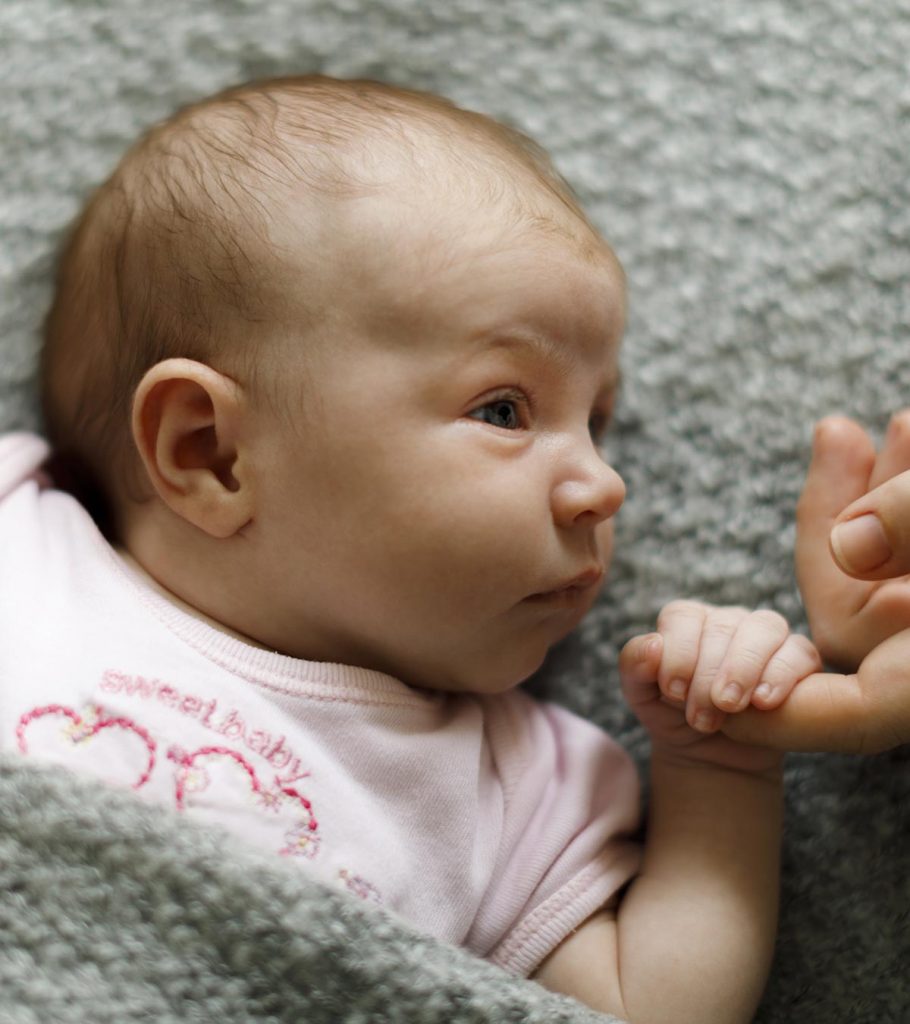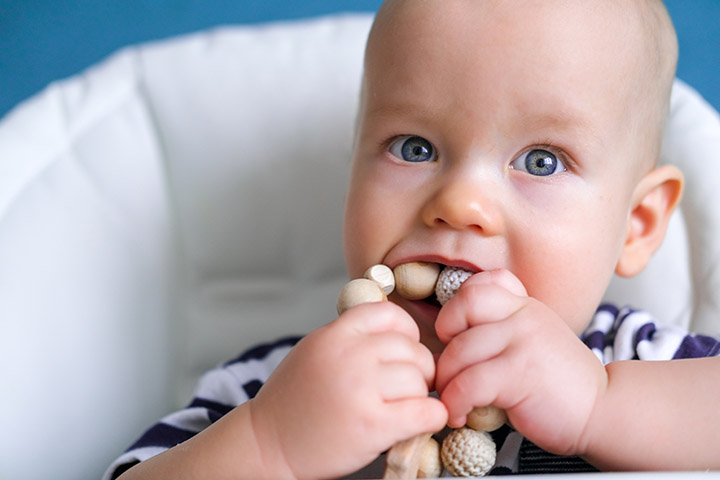When you observe one-month-old babies’ milestones in terms of development, you will notice how a whole new world unlocks for them at this age. They develop new abilities and are more responsive, physically dexterous, and cognitively capable than when they were born. So, at the age of one month, what other developmental milestones could you expect from your baby?
Continue reading to learn more about the developmental milestones of a one-month-old infant, when to be concerned about developmental delays, and some tips to help parents aid in their development.
One-Month-Old Baby’s Milestones Chart
| Achieved Developmental Milestones | Emerging Developmental Milestones |
|---|---|
| Eyes can track objects from mid-line to the side | Will track moving objects from side to side |
| Can lock an object that is placed in the hand | Attempts to swipe and hit objects within reach |
| Grips objects but cannot hold them in hand | Will hold objects for a brief period |
| Notices faces and people within range | Begins to notice their hands and legs |
| Makes throaty sounds | Starts making cooing sounds |
| Stops crying when held by a caregiver | Will stop crying at the sight of the caregiver |
| Displays all neonatal reflexes | Neonatal reflexes gradually disappear |
| Lifts head a bit during tummy time | Can lift head by 45º during tummy time |
| Stops crying and looks in the direction of sound or voice | Will respond to the primary caregiver’s voice with coos and throaty sounds |
| Moves limbs symmetrically, with very little cognizance of them | Will gradually learn that hands and legs are an extension of the body |
| Will recognize the mother’s breast but may not tell a bottle apart | Can differentiate between breast and bottle |
A One-Month-Old Baby’s Developmental Milestones
There are three primary areas of development: cognitive, physical, social & emotional, with unique developmental milestones in each category.
Cognitive developmental milestones
- Expects feeds at set intervals: Initially, the baby feeds any time you feed them. But when they are a month old, their body starts working by the clock, a cycle develops and they cry at specific intervals or when they are hungry. That is perhaps why babies usually cry at the same time each day, expecting a feed.
- Can distinguish tastes: A one-month-old baby will only have breast milk. Still, they notice changes in the taste of the milk when the mother eats something that could alter the taste or flavor of the milk in some way. The baby also seems to recognize the smell of breast milk (1). And know the difference between breast milk and bottle milk.
- Acknowledges the presence of an object or person: Hold an object close to the baby’s eyes, and you’ll find them looking at the object and maintaining eye-contact with it, thus recognizing its presence. Eye contact is extremely important.
- A memory of sensations and smells: The baby can differentiate a softer item from a rough, coarse one. They will display aversion towards contact with hard and rough items. There is also a preference for sweet smells and discomfort when exposed to bitter or harsh smells.
Physical milestones
- Can thrust arms: Thrust arms forward albeit with a jerky movement. It indicates improvement in muscle tone.
- Moves the limbs a lot: A one-month-old baby will move the limbs symmetrically, meaning that one limb will move the same way as another.
- Improved reach: You will notice that the baby can bring their hand to their mouth and eyes.
- Head flops backward when unsupported: The baby cannot yet support its head, so leaving the head unsupported when holding them in your arms or placing them in your lap can make it wobble backward. While this is not an achievement, it is an indicator of the healthy growth of the baby.
- Can raise or sway the head: Place the baby on the tummy, and they will engage in activities such as lifting head and swaying it from side to side. A one-month-old baby has better neck dexterity due to developed muscles and nervous system.
- Rolls hands into a tight fist: Your little one can roll the hand into a fist at will.
- Grasp objects: Place an object in the baby’s palm, and they gradually roll their fingers around it and try grasping it. They also try to grasp nearby objects on their own (2).
- Eyes can track objects: When you bring an object to the baby’s side and slowly move it towards the center (midline), the baby will be able to track the object. The same thing happens when you place the object in the center and gradually move it to the side. The eyes follow the object.
- Can focus on objects that are up to 12 inches away: The baby can focus on objects and recognize faces at a distance of 8-12in (20.3 to 30.4cm) away.
- Sleeping time decreases by half-an-hour: The number of sleeping hours decreases from 16 to 15.5 in a day. The baby will sleep nearly the same amount of time during the day and night (3). The sleep pattern remains the same.
- Presence of strong neonatal reflexes: Babies display a plethora of reflexes at birth, which persist at the age of one month (4). Your baby’s pediatrician will look for these reflexes during a regular developmental check-up. The absence of these reflexes can be an indicator of developmental delay. These include the Moro’s reflexiXA protective response in infants to sudden stimulation or disruption of body balance., the rooting reflexiXA reflex where babies open their mouth with their tongue thrusting when it is touched or stroked., the sucking reflex and the stepping reflexiXA reflex when your baby appears to take steps when held upright in the air or on ground..
Social & emotional milestones
- Cries to communicate: The baby uses crying and cooing as a medium to communicate their pain and discomfort. They tend to stop crying the moment a caregiver holds them and addresses their need. So, if the mother picks a crying baby and breastfeeds him/her, then they calm down right away. They may even try smiling softly at this point.
- Recognizes sounds and voices: The baby has a memory of voices and recognizes familiar sounds and voices. They turn their heads towards the source. Babies also begin to make throaty noises at this age.
At one month old, babies are thought to have the ability to distinguish their parents’ voices which becomes apparent through their responses. Ginny, mother of two daughters and a certified teacher, talks about the one-month old developmental milestones drawing from her experience with her daughter Mina in her YouTube channel Ginny the EdD. She says, “For Mina, it tends to help when she hears one of our voices – mine or my husband’s – to calm down when she has those colic episodes (i).”
- Makes eye contact: Stand close to the one-month-old baby and they will look straight at your face and then into your eyes. The babies at this age are adept at making eye contact when a face is within the field of vision.
- Prefers human faces: A baby’s gaze will first settle on a face, even in the presence of several brightly colored items within their field of vision. This one-month-old baby’s developmental milestones work in tandem with the baby’s new-found ability to acknowledge a person’s eyes.
- Can sense and react to rough handling: If you handle the baby roughly, then they are quite likely to make their dissent clear. Despite being a month old, babies can differentiate between gentle rocking and movements that are deliberately rough and abrupt. They enjoy being rocked gently (5).
The above milestones and abilities of babies indicate healthy growth. Some red flags in the baby’s development could offset the ideal benchmarks. More about them next.
When To Be Concerned About The Baby’s Development?
According to the American Academy of Pediatrics (AAP), the following signs indicate a developmental delay in a one-month-old baby:
- Feeds poorly with weak latch and suction. Basically, difficulty in sucking.
- Does not focus on a nearby object even when you move it from side to side.
- Does not blink eyes or moves face away when shown a bright light.
- Does not respond to sound or voices even when awake and fully alert.
- The baby’s body and muscles seem stiff. Limbs barely move.
- The body feels floppy when you pick the baby in your arms. You sense nearly no muscle control.
- There is a trembling movement in the lower jaw, even when the baby stays still.
The US Center for Disease Control and the AAP recommend regularly screening of the baby for developmental delays (6). The baby should be seen by a pediatrician for regular development milestones. As some points might be missed by the parent. If you feel something amiss in the baby’s health, then do not hesitate to raise the topic the next time you see the pediatrician.
That said, parents can also contribute positively to the baby’s development at this stage.
How Can Parents Help In The Development Of A One-month-old?
Here is what you can do to facilitate the healthy growth of your baby:
- Tummy time: Allowing your baby to spend a fixed time every day on their tummy helps strengthen nearly all muscles of their body. Pediatricians recommend placing the baby on its tummy around three to five times a day, with each tummy time session lasting two to three minutes, eventually increasing the duration as they grow. This also helps in neck holding (7). Place an interesting object or toy in front of them to make this activity interesting.
- Indulge in activities that stimulate: Fun games and activities such as tracking objects can enhance the baby’s skills. Set some amount of time for activities each day so that your baby has adequate practice to enhance their developmental abilities.
- Social interactions are essential: Social interaction from early on in life helps forge the essential skills that are useful later in life. A healthy dose of interaction with caregivers and family members also ensures positive development in each area of the baby’s growth (8).
While a one-month-old baby is too little, you will be surprised to know their learning capabilities. They develop at a rapid pace and achieve many milestones. Feeding at regular intervals, distinguishing between tastes, being able to move their limbs and roll their hands to make a tight fist are some of the many milestones they achieve by the end of the one-month mark. However, know that every baby is unique and reaches its milestones at its own pace. If you are concerned about any delay, do not panic but contact your healthcare provider.
Key Pointers
- One-month-old babies are capable of distinguishing different tastes and acknowledging the presence of others.
- They communicate through crying, can recognize voices, and attempt to make eye contact.
- If a baby fails to properly latch, blink at bright lights, or track objects, it is recommended to consult a pediatrician.
- Tummy time and social interactions are beneficial for a baby’s development during this month.
As a parent you must be worried about your infants’ healthy physical development. This video will help you learn about the milestones your one month old baby can reach and how to measure their growth.













